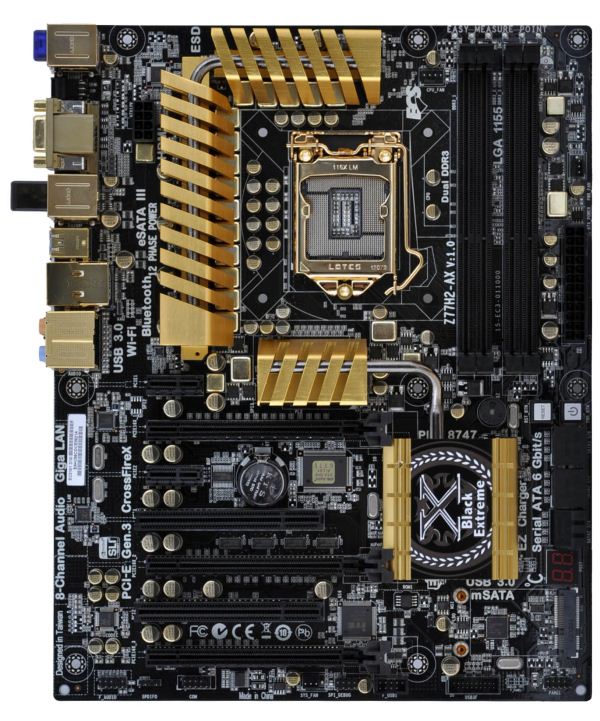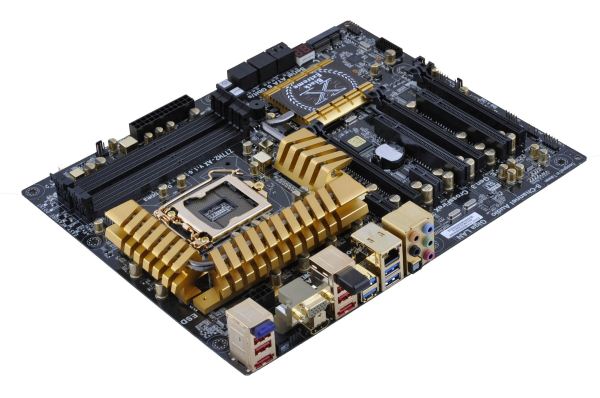Intel Z77 Panther Point Chipset and Motherboard Preview – ASRock, ASUS, Gigabyte, MSI, ECS and Biostar
by Ian Cutress on April 8, 2012 12:00 AM EST- Posted in
- Motherboards
- Intel
- Biostar
- MSI
- Gigabyte
- ASRock
- Asus
- Ivy Bridge
- ECS
- Z77
ECS Z77H2-AX—Visual Inspection
If all you ever wanted in life was something colored gold, I think ECS have you covered. As part of their Golden Board branding, the ECS Z77H2-AX has been plated with a layer of gold paint. Well, their heatsinks, heatpipes, socket, capacitors, VRMs and IO panel have all had a layer of gold paint added in order to improve aesthetics. When I first took this board out of the wrapper, I was figuratively blinded by just how much of the gold color was in my face.
Initially ECS will be releasing two high-end Z77 boards, with this one being the most expensive we have in for review, at an MSRP of $319. As such, I would expect it to perform near the top in almost every aspect—features, extras, performance and usability. As more than twice the price of the ASRock Z77 Extreme4, it had better be at least twice the board.
For a start, we can see that the socket is closed in, with the heatsinks and the memory slots being right up against Intel's minimum required socket spacing. This means big air coolers may not get a chance to fit, and only stock or water-cooling need apply. If that is the case, then I hope ECS have a robust overclock system in place.
One thing to feel disappointed by the ECS board though is the lack of fan headers. Around the socket you are lucky to have two—one 4-pin between the top VRM heatsink and the memory slots, and a 3-pin just above the 24-pin ATX power connector. A solitary third is on the bottom of the board. In the past ECS fan OS controls have had some of the better software support; however, it does not make sense to have only three headers on this.
Down the right hand side of the board, below the ATX power connector, are a pair of power/reset buttons, the standard six SATA ports from the PCH, and a two-digit debug display. Note we do not have any other SATA controllers for internal ports on the board. Below the two-digit debug display is an mSATA connector, which doubles up as a mini-PCIe if a user want to use a WiFi module (note, there is one on board already) or a TV Tuner.
On the south side of the board we are not given a vast amount of headers to say it is cramped—aside from standard front panel headers, there is a USB 3.0 header, a COM header, and a solitary USB 2.0 header.
This big selling point of this board over the other boards in this preview however is its multi-GPU capabilities. ECS have decided to invest in a PLX PXE 8747 chip, which is akin to the NF200 chips we saw on X58. This chip will expand the 16 PCIe 3.0 lanes on the board to 32, meaning that on the PCIe slots, we can have x16/x16 in dual card mode, or x16/x8/x8 in tri-card mode.
Thus in order we have an x1, an x16, x1, PCI, x16/x8, PCI, x8. So if all three full length PCIe slots are filled, there is still access to an x1 and a PCI, but we lose a lot of the functionality on the south part of the board.
The back panel has a mix and match of capabilities and functionality. From the left, we have a Bluetooth dongle, two USB 2.0 (red), an eSATA, a clear CMOS button, D-Sub, HDMI, a WiFi dongle, two USB 2.0, an eSATA, two USB 3.0, gigabit Ethernet, two USB 3.0, optical SPDIF and audio jacks. The big selling point for me is the WiFi, which ECS have cunningly added to their top range boards for a few chipsets now.
Board Features
| ECS Z77H2-AX | |
| Size | ATX |
| CPU Interface | LGA-1155 |
| Chipset | Intel Z77 |
| Power Delivery | 12 + 2 |
| Memory Slots |
Four DDR3 DIMM slots supporting up to 32 GB Up to Dual Channel, 1066-2800 MHz |
| Video Outputs | HDMI, D-Sub |
| Onboard LAN | Realtek 8111E |
| Onboard Audio | Realtek ALC892 |
| Expansion Slots |
2 x PCIe x16 Gen3 (x16, x8/8) 1 x PCIe x16 Gen2 (x4) 2 x PCIe x1 Gen2 2 x PCI |
| Onboard SATA/RAID |
2 x SATA 6 Gbps (PCH), Support for RAID 0, 1, 5, 10 4 x SATA 3 Gbps (PCH), Support for RAID 0, 1, 5, 10 2 x eSATA 3 Gbps |
| USB |
6 USB 3.0 ports (4 back panel, 2 from headers) 6 USB 2.0 ports (4 back panel, 2 from headers) |
| Onboard |
2 x SATA 6 Gbps 4 x SATA 3 Gbps 1 x USB 3.0 Header 1 x USB 2.0 Header 3 x Fan Headers 1 x COM Header 1 x SPDIF Output Header 1 x Front Panel Audio Header Power/Reset Buttons Debug LED 1 x mSATA |
| Power Connectors |
1 x 24-pin ATX connector 1 x 8-pin 12V connector |
| Fan Headers |
1 x CPU Fan Header (4-pin) 1 x SYS Fan Header (3-pin) 1 x PWR Fan Header (3-pin) |
| IO Panel |
4 x USB 3.0 Ports 4 x USB 2.0 Ports 1 x HDMI 1 x D-Sub 1 x Gigabit Ethernet 1 x Optical SPDIF Output 1 x Clear CMOS Button 1 x Wifi Connector 1 x Bluetooth 2 x eSATA 3 Gbps Audio Ports |
| Warranty Period | 3 Years from date of Purchase (3yr parts, 2yr labor) |
| Product Page | Link |
Despite having WiFi, mSATA and extended PCIe 3.0 lanes, the ECS board is down on audio (Realtek ALC892 rather than ALC898 of others), lacking fan headers and also lacking video outputs, with a lot of people requiring DVI to D-Sub or DVI to HDMI connectors.













145 Comments
View All Comments
extide - Tuesday, April 10, 2012 - link
Do you even know what it means to preempt a frame? Cavalcade is describing the technology correctly. He is explaining pretty much the same thing as you are but you just don't get it..Also separate input and rendering modules means a lot. Typically a game engine will have a big loop that will check input, draw the frame, and restart (amongst other things of course) but to split that into two independent loops is what he is talking about.
Iketh - Wednesday, April 11, 2012 - link
You really should look up "preemption." This is not what is happening... CLOSE, but not quite. Preemption is not the right word at all. This makes him incorrect and I kindly tried explaining. You are incorrect in backing him up and then accusing me of being inept. Guess what that makes you?On top of that, he's also not talking about splitting input and rendering into two loops. Not even close. How did you come up with this idea? He's asking how the input polling is affected with this technology. It is not, and can not, unless polling is strictly tied to framerate.
I want to be clear that I'm not for this technology. I think it won't offer any tangible benefits, especially if you're already over 100 fps, and they want to power up a second GPU in the process... I'm just trying to help explain how it's supposed to work.
Iketh - Sunday, April 8, 2012 - link
"handling input in a game engine" means nothing here. What matters is when your input is reflected in a rendered image and displayed on your monitor. That involves the entire package. Lucid basically prevents GPUs from rendering an image that won't get displayed in its entirety, allowing the GPU to begin work on the next image, effectively narrowing the gap from your input to the screen.Iketh - Sunday, April 8, 2012 - link
mistake post, sorryRyan Smith - Sunday, April 8, 2012 - link
The bug comment is in regards to HyperFormance. Virtual V-Sync is rather simple (it's just more buffers) and should not introduce rendering errors.Ryan Smith - Sunday, April 8, 2012 - link
Virtual V-Sync is totally a glorified triple buffering, however this is a good thing.http://images.anandtech.com/reviews/video/triplebu...
Triple buffering as we know it - with 2 back buffers and the ability to disregard a buffer if it's too old - doesn't exist in most DirectX games and can't be forced by the video card. Triple buffering as implemented for most DirectX games is a 3 buffer queue, which means every frame drawn is shown, and the 3rd buffer adds another frame of input lag.
On paper (note: I have yet to test this), Virtual V-Sync should behave exactly like triple buffering. The iGPU back buffer allows Lucid to accept a newer frame regardless of whether the existing frame has been used or not, as opposed to operating as a queue. This has the same outcome as triple buffering, primarily that the GPU never goes idle due to full buffers and there isn't an additional frame of input lag.
The overhead of course remains to be seen. Lucid seems confident, but this is what benchmarking is for. But should it work, I'd be more than happy to see the return of traditional triple buffering.
HyperFormance is another matter of course. Frame rendering time prediction is very hard. The potential for reduced input lag is clear, but this is something that we need to test.
DanNeely - Monday, April 9, 2012 - link
Lucid was very confident in their Hydra solution; but it never performed even close to SLI/xFire; and after much initial hype being echoed by the tech press it just disappeared. I'll believe they have something working well when I see it; but not before.JNo - Monday, April 9, 2012 - link
Thisvailr - Sunday, April 8, 2012 - link
Page 8 quote: "The VRM power delivery weighs in at 6 + 4 phase, which is by no means substantial (remember the ASRock Z77 Extreme4 was 8 + 4 and less expensive)."Yet: the "Conclusions" chart (page 14) shows the same board having 10 + 4 power.
Which is correct?
flensr - Sunday, April 8, 2012 - link
I'm bummed that ASUS didn't include mSATA connectors. Small mSATA SSDs would make for great cache or boot drives with no installation hassles and they're pretty cheap and available at the low capacities you'd want for a cache drive. That's a feature I will be looking for with my next mobo purchase.Ditching USB 2.0 is also one of the next steps I'll be looking for. Not having to spend a second thinking about which port to plug something in to will be nice once USB 2.0 is finally laid to rest. Having only 4 USB 3.0 ports is stupidly low this long after the release of the standard, and it's hampering the development of USB 3.0 devices.
Finally, I've been repeatedly impressed by my Intel NICs over the last decade. They simply perform faster and more reliably than the other chips. I look for an Intel NIC when I shop for mobos.